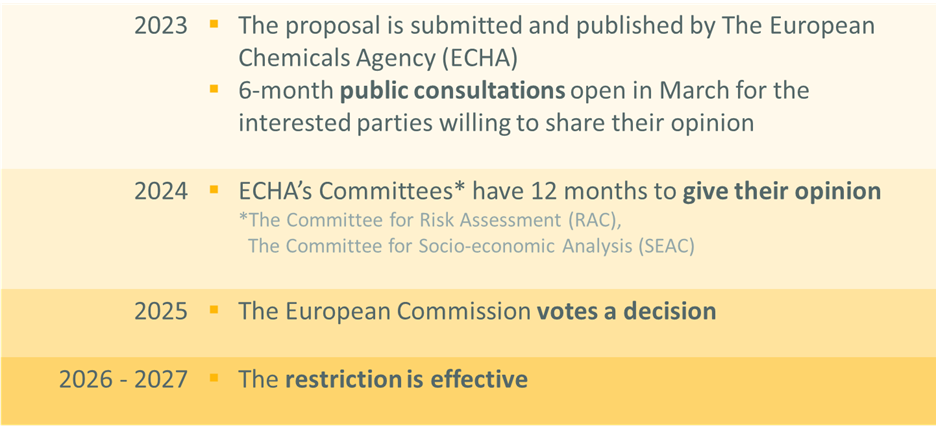Reason 1: The scope of substances is huge
After the proposal was officially submitted a couple of months ago, everything seems more serious and real.
This time the definition of PFASs is very broad, impacting more than 10,000 compounds, according to European Chemicals Agency (ECHA).

The proposal considers that the PFASs must be regulated basically all together the same way. No matter what are their uses, properties, or toxicological profiles.
Notably, fluoropolymers are also in, as long as PFAS-based processing aids are used for their manufacturing (i.e., PTFE to name the most popular one, ETFE, FEP, PFA, PVDF…).
The following applications using fluoropolymers, have not received time-related derogations, and are as of today subjected to immediate ban if the restriction becomes effective:
…batteries for EV, water and atmosphere purification, water electrolysis, energy & hydrogen storage, equipment (i.e., seals, gaskets, tubing, wire & cable) for pharmaceutical manufacturing, electronics, aerospace, military & defense, transportation, semiconductor manufacturing, etc.
We will certainly know more later this year. We can surely expect changes and some applications might be excluded from the limitations, at least temporarily.
However, no one can guarantee the legislator will not decide to review the exempt applications a few years later.
The bigger the scope, the more opportunities too.
Reason 2: The timeline is short
The proposal says: if the restriction becomes effective, the import and the manufacturing of PFAS will be banned in Europe within 18 months of its implementation.

The timetable is rather little and there are limited options for derogations (up to 12 years depending on the application).
Can this really happen that quickly?
Looking at chemicals and materials history, the short answer might be ‘No’. Suppliers of PFAS and all related parties will understandably try to argue and influence the decision. We can assume that it may take the EU years to push such a restriction through.
The truth is no one knows. This might really take many years.
What also takes a long time is testing and implementing alternative solutions.
Who will take the bet to wait for the last moment? You cannot buy back lost time.
Reason 3: The market has already been impacted
The potential impact of such a ban, both on the suppliers and the users, was recently almost unthinkable.
140K to 310K tonnes of PFAS were sold in Europe in 2020, as reported in the draft proposal.
And, you do not necessarily have to be based in Europe to bear the consequences. If the restrictions are applied, the ban will impact >75% of the US industry (according to The Fluoropolymers Product Group of Europe’s leading fluoropolymer producers).
For example, companies importing fluoropolymers from the US to EU will see their market closed.
Big players have announced massive changes and processes such as fluoropolymers (i.e., PTFE) production have already been shattered.
- Some are discontinuing PFAS production (as soon as 2025 in the case of 3M)
- Some have committed to limiting the use of PFAS to "essential industrial applications" (DuPont)
- Others have developed PFAS-free processes to make fluoropolymers (Arkema, Solvay)
The proposal submitters state themselves that “in many cases, no such alternatives currently exist, and in some they possibly never will".
The customers know that better than anybody else. In the best case, they will engage in lengthy and time-consuming materials screening, testing and product redesigning.
They also know they must deal with this as soon as possible.
Reason 4: The users actively search for PFAS substitutes
The users cannot afford to wait. They have already started looking for alternatives.
At SpecialChem we record a clear increase of the interest for PFAS substitutes on our specialized platforms for plastics, coatings, adhesives, and sealants.
Actually, PFAS-free materials have reached the top 5 most searched additives in the last three months.
There are clearly uncertainties about the future. There are clearly application areas with no evident solutions (pipes, tubing, coatings…that list is very long). Further scientific and socio-economic data will support the decision whether to keep or not current chemicals as the only viable option.
However, many materials available on the market could be interesting for application areas where PFAS have been undisputed leaders, including in segments that require:
What you can do is listen to the customers and go talk to them.
We do this daily: we ask the users what they are looking for and help them connect with suppliers. Digital platforms like SpecialChem, are the ideal place to collect direct market feedback and engage with the industry (and with us you can also do this anonymously).
Do you have available solutions? Let the market know.

